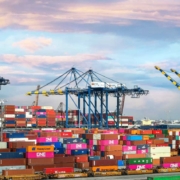Successfully realize E-fulfillment strategy.
Many organizations have brought an enormous diversity of products to market in recent years under pressure from consumer demand. This has created an extremely complex global supply chain.
This complexity contributes to the fact that stocks are difficult to control, a lot of capital is fixed and margins are under pressure. In this piece a number of handles to regain control of your supply chain.
Challenges.
How can you regain control of a supply chain where customer demand has become increasingly unpredictable and volatile? With increasing uncertainty, the danger of the bullwhip is increasing. End-to-end collaboration is then more necessary than ever.
This is not just about information, but also about technology and operational cooperation. Harmonizing data, ensuring that clear and unambiguous performance indicators are set up throughout the supply chain. But also linking the [future] customer demand to product design and actual production.
Joint forecasting
Also known as CPFR ensures that potential customer demand is available in real time throughout the chain. Web based solutions offer good solutions here because of the relatively simple connection and the advantages of internet standards. You have immediate insight into whether the chain can switch quickly enough and where the bottlenecks will arise.
Control tower.
A supply chain tower is more than a central order processing point. It ensures that different formats of data are coordinated, monitors your stock and production flows and synchronizes this with your customer demand. Affiliated parties such as logistics service providers or distributors obtain real-time information about order status and turnover. In addition, the control tower can identify bottlenecks along the entire chain and set up targeted improvement processes to achieve further optimization.
Sales and Operations planning.
S&OP harmonizes your actual customer demand not only within your own chain from purchasing to sales but also the affiliated parties such as suppliers and logistics service providers. This allows the chain to respond more quickly to deviations and communicate them directly. This lowers costs in cover and improves customer service levels.
Product introduction
Ensuring that product and packaging is closely involved in sales and marketing avoids unnecessary setbacks when introducing a new formula to the market. Customers are demanding smaller lot sizes and more sustainable packaging. This requires a new approach to your product design. It is also important to take your logistics challenges here. For example, think of Ikea which has now made all products ‘flat’ for optimal transport options at the lowest possible cost.
Strategic purchasing
The most difficult is which procurement you will arrange centrally and where decentralized is the best solution. Economy of scale is very tempting, but decentralized regularly proves to be a better solution when it comes to responding quickly and flexibly. This challenge leaves the importance of a chain-wide strategic procurement strategy where these types of issues are emphatically investigated. It is also possible to look carefully where the purchasing stock must be deposited.
Vendor management inventory
The previous is in line with the adjustment of VMI. The advantage for suppliers is that they can maintain lower inventory because they immediately observe developments within the chain. There are advantages for both parties to reduce the costs of inventory and to achieve improved flexibility.
Responsive supply chains.
As developments on the demand side become increasingly uncertain and demand changes faster, flexibility and agility of your supply chain is of great importance. The time of large-scale cost benefits from mass production is increasingly fading into the background. The increasing differentiation in demand and higher service requirements make completely new demands. Cost control and maintaining a good margin will now have to be earned with a responsive supply chain.









